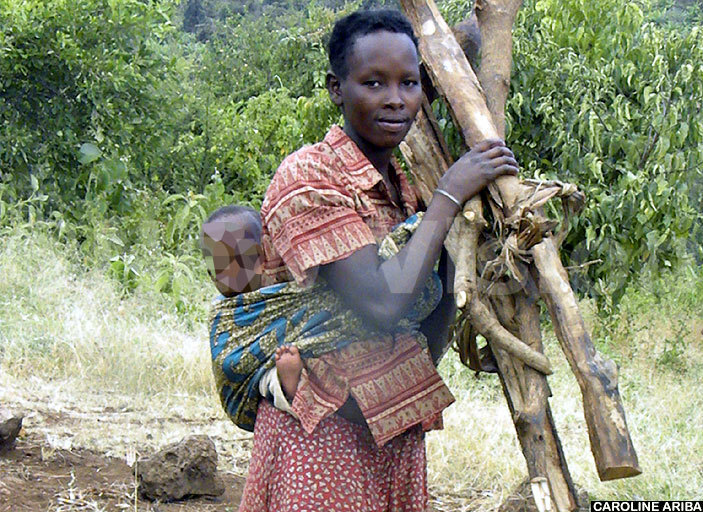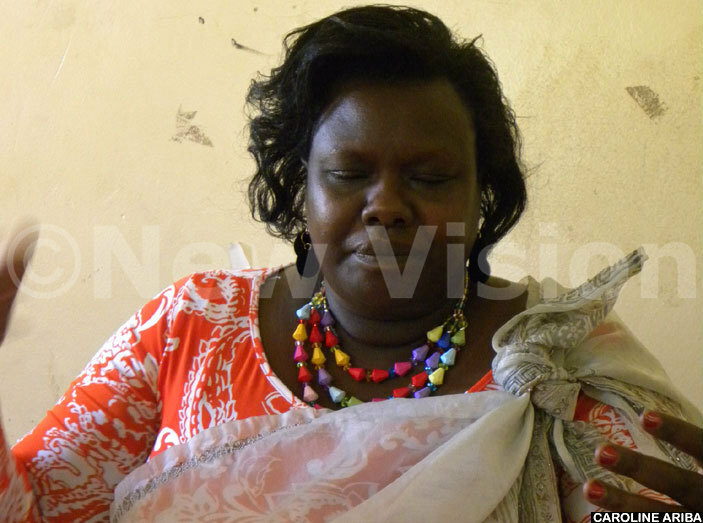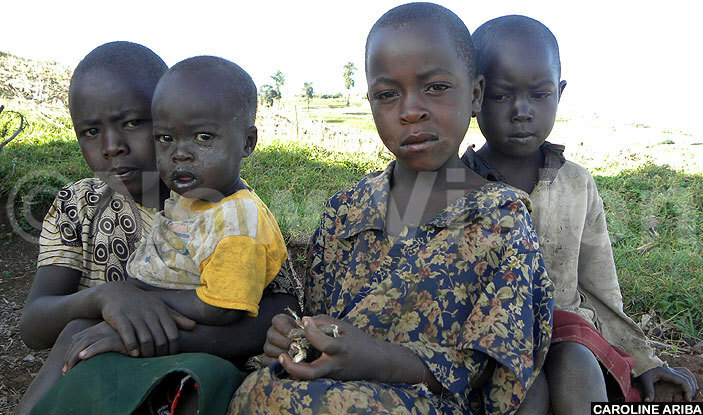FGM: A tale of force, emotional blackmail and evil dreams
The closer the rusty blade got to her, the more frightened she was.
She saw the blade, but dared not move. That was the command! If she did, it would haunt her, her children and the generations to come. That was the cultural notion.
_______________________________________
Syada Chebet, only a teenager then, told herself it was indeed for the best. So if she braved the knife, that funny-looking blade, just for a second, it would be just fine.
Her future would be just fine. It was only part of her genitalia, it should be fine, she thought.
"It will not take long, it cannot take long," she soothed herself. She would let the wrinkly and mean-looking old lady sucking on a tobacco pipe, cut her genitalia. After all, they said it should take a second, right? No, it did not!
The closer, the rusty blade got, the more frightened she got. So, she thought to herself: "I can run, I will run!" Sadly, before she could react, two giant men tore her thighs apart, and pressed them on each side.
"Stay down!" they commanded, all the while stepping on her thighs.
The old woman, also the village's mutilation surgeon, had since abandoned her pipe and had now started speaking like she was possessed. With her rough fingers, the old woman latched onto Chebet's genitalia, and pulled.
Turned out the blade wasn't as sharp as it should have been. Up and down the surgeon tore through her flesh like one does tough beef. She did not let go till she was holding a piece of Chebet's genitalia in her hands!
A bleeding Chebet had been rendered immobile by the giant men that pinned her on the grass, making sure the old woman cut just the right amount of flesh. The spectators cheered on like she was a notorious village bull meeting its death. It eventually did end, and Chebet, who hails from the remote Kween district in the Sebei region in eastern Uganda, was left to the tussle of healing.
"What didn't I use to try and heal!" she speaks years later of a practice she now despises with a passion. "They said that I cross my legs when urinating and it would help, but it did not. They told me to press with hot water, all I felt was pain."
What should have taken a week to heal dragged on for nearly a month.
"I smelled badly, yet I did not see any good luck that was promised!" Chebet now in her 30s says. So when there was a run to raise awareness against Female Genital Mutilation (FGM), she was among the first on the line.
What is this practice?
 Rachael Chebet went through FGM when five months pregnant
Rachael Chebet went through FGM when five months pregnant
To the locals, it is female circumcision, but experts call it Female Genital Mutilation. It is defined by the World Health Organization (WHO) as the partial or total removal of the external female genitalia for cultural and other non-therapeutic reasons.
This definition has been refuted by those that support the practice, calling it an attempt at demonizing what should be a "lovely" culture. "It is circumcision, like that of men!" roars elder Joseph Kapchengwen, from Kapchora.
However, a 2007 report on FGM by the WHO also notes that FGM reflects a deep-rooted inequality between sexes, and constitutes an extreme form of discrimination against women. It further refutes any claims that FGM has neither use nor health benefits.
Inspite of these findings, the United Nations Population Fund (UNFPA), estimates that more than 125 million girls in 29 countries in Africa and the Middle East have gone through FGM. World-wide though, the WHO estimates that about 140 million girls and women are living with the consequences of the practice. It calls the practice a violation of human rights.
Sadly, in high-prevalence countries, projections by UNFPA and UNICEF indicate that 15 million girls are at risk of being cut by 2020.
In Uganda, FGM is practiced in the eastern districts of Kapchorwa, Kween and Bukwo, which are home to the Sabiny tribe. UNFPA estimates that in this area, at least 50% of women and girls undergo it in their lifetime.
So if the 2011 data from the region estimates the region to have at least 200, 000 people yet 51% of Uganda's population is women, it would mean that 50, 000 women undergo FGM in the three districts.
It gets worse in the north-astern region of Karamoja.
Among the region's Pokot and Tapeth in Amudat, Nakapiripirit and Moroto, 95% of women, and girls undergo the practice. It is no wonder that the 2011 Uganda Demographic Health Survey states that up to 490, 000 Ugandan women are suffering from the adverse effects of FGM.
Speaking of the effects, Beatrice Chelengat, an expert on FGM and director of Reproductive Educative and Community Health (REACH) Programme says: "Before anything happens, the first effect is excruciating pain, shock, loss of blood and sometimes infections. Do you know that these can result in death?"
 Beatrice Chelengat says the effects of FGM can lead to death
Beatrice Chelengat says the effects of FGM can lead to death
She argues that FGM surgeons do not have a single medical skill, let alone knowledge of the human anatomy, except just stumbling on discoveries. "If the woman is bleeding uncontrollably, many of them have no idea what to do."
Even worse, Chelengat says, many times the local surgeons do not use sterilized instruments, and expose the victims to HIV and Hepatitis and even Tetanus.
But even beyond the exposure is the scare, which Chelengat says can be terrible for many women. "Some of these scars do not look good, some swell, block the passages, and sometimes will cause obstacle during childbirth which could lead to Obstetric Fistula."
Dr. Charles Kimbugwe of Mengo People's Clinic agrees that it is possible for all said conditions to happen. "Anything that involves cutting of one's body could lead to over bleeding and several infections.
"And in this case, it could definitely lead to complications in child birth that could lead to Obstetric Fistula."
Why does it go on?
Media has been awash with stories of those battling adverse effects of FGM, but still the practice goes on. In Kween district, Catherine Cherotich died after a mutilation whilst giving birth, leaving four children motherless.
 The late Cherotich's children orphaned as a result of FGM
The late Cherotich's children orphaned as a result of FGM
Nursing aids Betty Chespi and Monica Cheruikut working at Kapchorwa Hospital were left paralyzed after FGM. Images of rotting genitalia have been passed around, a law against the practice is in place, anything to discourage those practicing, but still it rears its head.
All these did not stop a five-month pregnant Rachael Chebet then, who hails from Matingot village in Kapchorwa from sneaking off to the banana plantation in the night to get circumcised last year. Yes, pregnant!
"As soon as the circumcision period reaches, I start having bad dreams, something is telling me to circumcise," the 21-year-old mother of three who was arrested last year and got released on a presidential pardon only two months ago.
She did not do this alone. Her friends Esther Cherop, a 28-year-old mother of three confesses that she too was haunted by the same evil dream. Not far from her was 22-year-old Jacklyn Cherotich, who even confessed that she finds herself whisked out of bed and dancing.
 Racheal Chebet had her baby in Jail
Racheal Chebet had her baby in Jail
Interestingly though, they each refused to name the person who did the mutilating, as it would be viewed as a taboo. When I asked if their husbands had one way or the other coerced them into the practice, they were quick to refute. "No, aah aah…" they each refused.
However, medical social worker Gladys Ariono of Family Health says that sometimes these men do not have to say anything. "Just be silent and not say a word, or avoid the woman, and sometimes that will drive the women into anything they think will keep the man from straying."
A chat with Martin Cherop (Rachael Chebet's husband) might indeed prove the social worker's argument. When asked how he had learned his wife had been mutilated, he said it was through a friend, and just rumors.
Puzzled, I asked if he had noticed anything different about his wife and he just shook his head.
 Martin Cherop says he did not know his wife had undergone FGM
Martin Cherop says he did not know his wife had undergone FGM
William Chesabit, an ardent activist against the practice in Kapchora, told New Vision that mind-games and emotional blackmail are the biggest tools used to lure the women into FGM. He says that uncircumcised women are not allowed to get food from the granary or collect cow dung used to plaster mud-and-wattle huts.
"Can you imagine, you cannot even touch cow dung!" Should the women defy these rules and do what they want anyway, they will be blamed for everything wrong that happens in the homestead.
Even worse, when one dies uncircumcised, there body is thought cursed, and not allowed through the front door. Yes, they would rather break a wall, than risk the wrath of the "evil spirits".
A concerned Rev. Justus Chellongat of All Saints Kapchorwa tells New Vision that even as the religious fight to untaint these minds, they have found another way to trap the women. "If a girl landed on a fiancé whose father is a culture die-hard, it would be trouble. "He would not allow to pay dowry for an 'unclean' girl," he said.
The law
It is for reasons like this that Government put in place an anti-FGM law in 2010.
Patrick Okiror, a city lawyer, breaks down the law in detail. "No doubt, what this law is here to do is put an end to FGM. We have jail terms from six months to life imprisonment, which shows Government's commitment."
He says that should one be found guilty of carrying out FGM, one could get a sentencing of up to 10 years in jail. If one does it by themselves, the sentence remains the same. "It is called aggravated FGM and worsens when adverse complication occurs, like contracting HIV. That could get one life imprisonment."
If one were to falsely participate in events that lead to FGM, Okiror explains, one could garner up to five years in jail, while those who hide those involved, or not report in 24 hours to the authorities, could get up to six months in jail or pay a sh20, 000 fine, an equivalent of US$5.
 The writer points at the banana plantation in Matingo village where FGM has been carried out
The writer points at the banana plantation in Matingo village where FGM has been carried out
Despite this, local leaders say they can only work with different systems in place. Rose Toskin, a local councilor at Mantingot village in Kapchora which had nearly 10 of its residents charged with FGM, says that a lot more than just the law could help.
"First of all, do the people even know this law in detail?" she asks.
"Have you educated them about FGM in detail? You know, like just building more schools." She blames illiteracy, lack of exposure and ignorance, fueled by peer pressure, to the continuation of the practice.
To beat the law, the perpetuators have taken to unpredictability. "For example, this year, there isn't circumcision, so even the authority was relaxed, but we heard that it happened in some villages," Toskin says.
Also, it doesn't help that some of the roads are bad, and the police stations are miles away. "So, these girls are left in the hard-to-reach areas with no-one to fend for them.
However, UNFPA Country representative, Esperance Fundira believes that instead of clinging onto FGM, the locals need to appreciate the other aspects of their culture. "I have heard so many good things about the Sabiny tribe and your rich culture."
"There are also community celebrations such as marriage, storytelling, the great food and the beautiful traditional cloth," says Fundira.
It is possible to give up FGM without giving up the meaningful, positive aspects of culture," she offers.